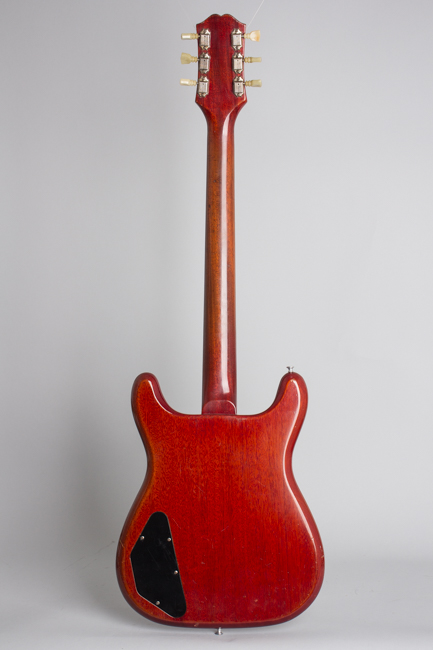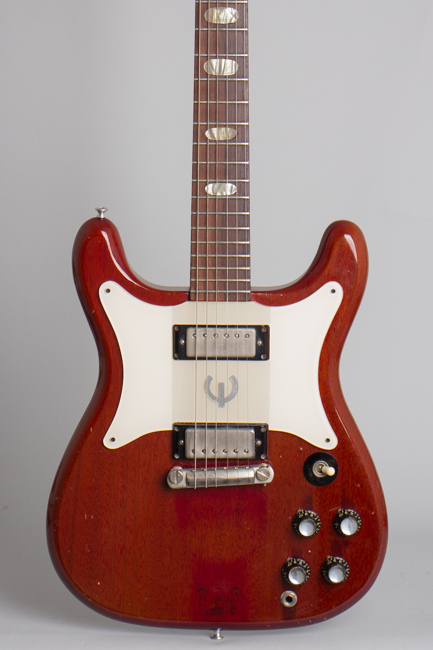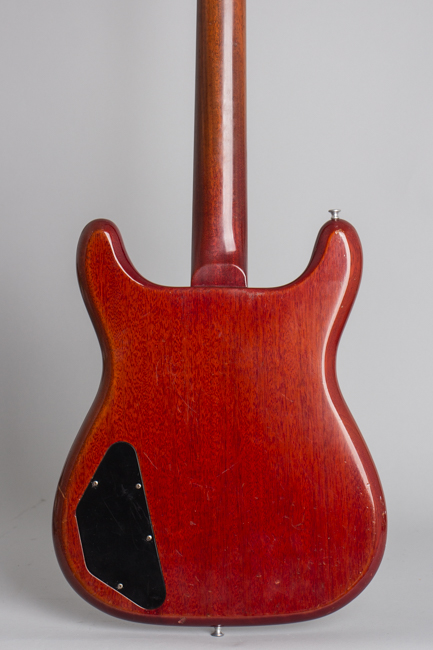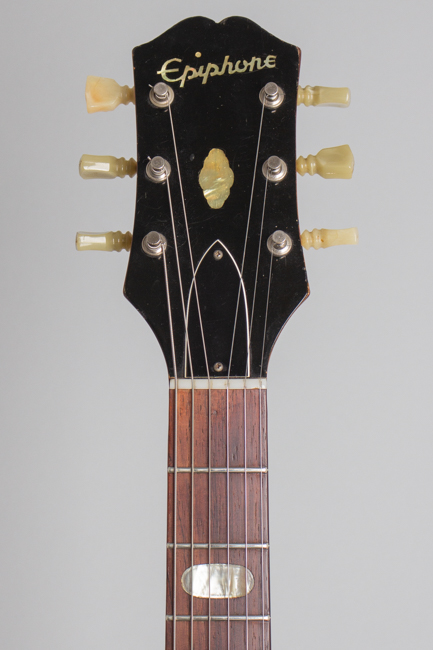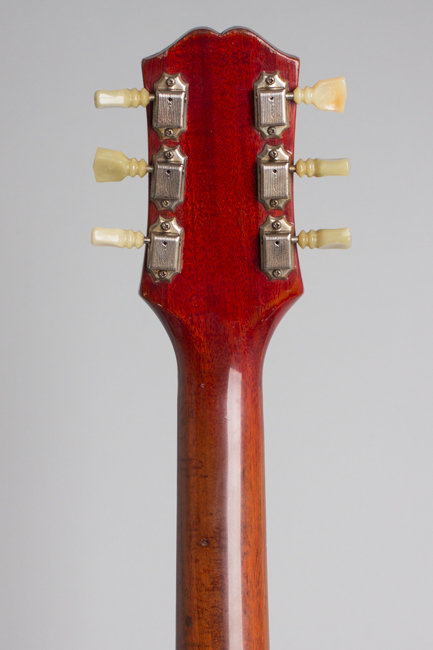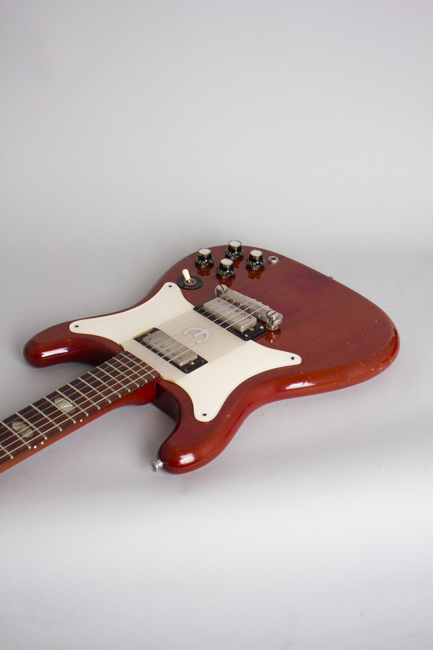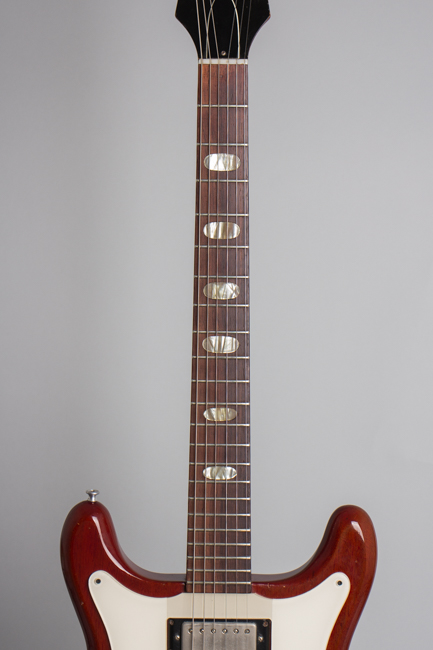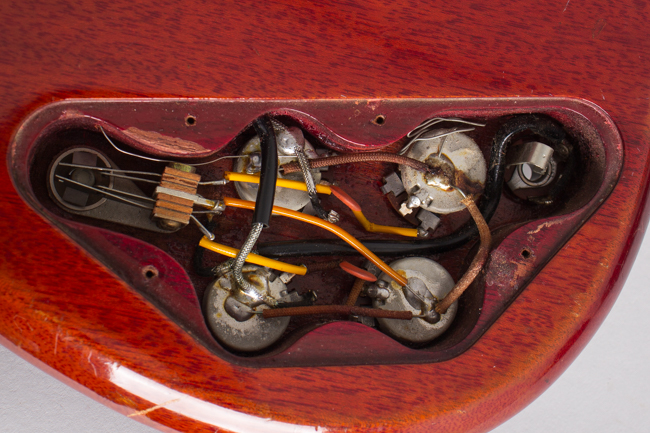Epiphone Crestwood Custom Solid Body Electric Guitar (1963)
Item # 12049
Prices subject to change without notice.
Epiphone Crestwood Custom Model Solid Body Electric Guitar (1963), made in Kalamazoo, Michigan, serial # 123452, cherry lacquer finish, mahogany body and neck, rosewood fingerboard, black gig bag case.
This is a cool and somewhat unusual example of the second variant of Gibson's Epiphone branded "SG Standard" equivalent, the Crestwood Custom. It has had one noticeable modification; the original Tune-O-Matic bridge and Vibrola unit have been removed and a simple Gibson style stud bridge/tailpiece mounted. This gives the guitar the feel of the Epiphone Coronet or Gibson SG Junior/Special; If you've ever wanted a Crestwood that feels and plays like one of those stoptail models this is your guitar! This could be reversed with some effort (mostly in filling/re-drilling the stud holes) but the guitar plays and sounds great as it stands, and now sports rather a unique combination of features as only P-90 single pickup instruments were typically built with the solid bar bridge.
This Crestwood Custom likely dates to mid-1963; the visible pot date is to the 20th week of that year. From 1960 up through late '63 all Epiphone solidbodies were built with symmetrical double cutaway bodies and a Gibson-like 3-on-3 headstock. For the 1964 model year the entire line was re-modeled into a more Fender-esque design with a single-sided "batwing" headstock and uneven cutaways. The re-styled line was somewhat more successful but all these the Epiphone solidbodies are fairly rare as they never gained the prestige or professional acceptance of their Gibson equivalents, despite being made alongside them in the same factory!
The Crestwood custom carries the same cherry finish on the body and neck as the much more common SG standard; they were also offered in a more rarely seen white finish. All hardware is nickel plated and includes two mini-humbucking pickups, which had been specially designed for this line. The pickguard is an unusual "half-clear" back-painted design with a shaded center, sporting an Epiphone "E" logo. The knobs, switch and Kluson Deluxe tuners are all shared with the Gibson branded SG.
The unbound rosewood fingerboard has unusual oval pearloid inlays specific to this model. The neck is a bit chunkier than the flatter profile typical of 1960-62 with more depth and a rounder feeling back. In 1963 this model was the top of the Epiphone solidbody line as the fancier three-pickup Crestwood Deluxe had not yet been introduced. This is a very light, handy and rather hot-sounding guitar with a particularly snarly tone when cranked up. The bridge is a modern compensated nickel unit with a staggered top edge designed for an unwound G string. The bridge change is not historically correct but has resulted in a really great feeling and sounding instrument, a unique twist on this already rare model.
Overall length is 37 1/2 in. (95.2 cm.), 13 in. (33 cm.) wide at lower bout, and 1 3/8 in. (3.5 cm.) in depth, measured at side of rim. Scale length is 24 3/4 in. (629 mm.). Width of nut is 1 11/16 in. (43 mm.).
This guitar shows fairly light general wear overall, and remains original except for the bridge modification as noted. Crucially it has none of the all-to-common breaks at the heel or headstock, with a great neck angle and perfectly solid untouched heel joint. There is some light/moderate finish wear; the cherry has faded in most areas to a more muted hue (most notable on the back of the neck) and has a nice \patina. There are small dings, dents and scuffs overall but not too much in the way of heavier finish wear. There is a bit of light touch-up over the holes in the top where the vibrato once mounted.
The tailpiece is a recent compensated stoptail; the strap buttons and switch tip are the correct style but more recent and the other hardware remains original including the mini-humbucking pickups and wiring rig, which just shows a newer ground wire to the bridge added to the original pots, caps and leads. The guitar has been neatly refretted with correct style wire and shows no notable wear. This is a great-sounding instrument and a really superb player, with the more in-your-face tone of the solid bar bridge added to pickups that really sing. Overall Excellent - Condition.
This is a cool and somewhat unusual example of the second variant of Gibson's Epiphone branded "SG Standard" equivalent, the Crestwood Custom. It has had one noticeable modification; the original Tune-O-Matic bridge and Vibrola unit have been removed and a simple Gibson style stud bridge/tailpiece mounted. This gives the guitar the feel of the Epiphone Coronet or Gibson SG Junior/Special; If you've ever wanted a Crestwood that feels and plays like one of those stoptail models this is your guitar! This could be reversed with some effort (mostly in filling/re-drilling the stud holes) but the guitar plays and sounds great as it stands, and now sports rather a unique combination of features as only P-90 single pickup instruments were typically built with the solid bar bridge.
This Crestwood Custom likely dates to mid-1963; the visible pot date is to the 20th week of that year. From 1960 up through late '63 all Epiphone solidbodies were built with symmetrical double cutaway bodies and a Gibson-like 3-on-3 headstock. For the 1964 model year the entire line was re-modeled into a more Fender-esque design with a single-sided "batwing" headstock and uneven cutaways. The re-styled line was somewhat more successful but all these the Epiphone solidbodies are fairly rare as they never gained the prestige or professional acceptance of their Gibson equivalents, despite being made alongside them in the same factory!
The Crestwood custom carries the same cherry finish on the body and neck as the much more common SG standard; they were also offered in a more rarely seen white finish. All hardware is nickel plated and includes two mini-humbucking pickups, which had been specially designed for this line. The pickguard is an unusual "half-clear" back-painted design with a shaded center, sporting an Epiphone "E" logo. The knobs, switch and Kluson Deluxe tuners are all shared with the Gibson branded SG.
The unbound rosewood fingerboard has unusual oval pearloid inlays specific to this model. The neck is a bit chunkier than the flatter profile typical of 1960-62 with more depth and a rounder feeling back. In 1963 this model was the top of the Epiphone solidbody line as the fancier three-pickup Crestwood Deluxe had not yet been introduced. This is a very light, handy and rather hot-sounding guitar with a particularly snarly tone when cranked up. The bridge is a modern compensated nickel unit with a staggered top edge designed for an unwound G string. The bridge change is not historically correct but has resulted in a really great feeling and sounding instrument, a unique twist on this already rare model.
Overall length is 37 1/2 in. (95.2 cm.), 13 in. (33 cm.) wide at lower bout, and 1 3/8 in. (3.5 cm.) in depth, measured at side of rim. Scale length is 24 3/4 in. (629 mm.). Width of nut is 1 11/16 in. (43 mm.).
This guitar shows fairly light general wear overall, and remains original except for the bridge modification as noted. Crucially it has none of the all-to-common breaks at the heel or headstock, with a great neck angle and perfectly solid untouched heel joint. There is some light/moderate finish wear; the cherry has faded in most areas to a more muted hue (most notable on the back of the neck) and has a nice \patina. There are small dings, dents and scuffs overall but not too much in the way of heavier finish wear. There is a bit of light touch-up over the holes in the top where the vibrato once mounted.
The tailpiece is a recent compensated stoptail; the strap buttons and switch tip are the correct style but more recent and the other hardware remains original including the mini-humbucking pickups and wiring rig, which just shows a newer ground wire to the bridge added to the original pots, caps and leads. The guitar has been neatly refretted with correct style wire and shows no notable wear. This is a great-sounding instrument and a really superb player, with the more in-your-face tone of the solid bar bridge added to pickups that really sing. Overall Excellent - Condition.


